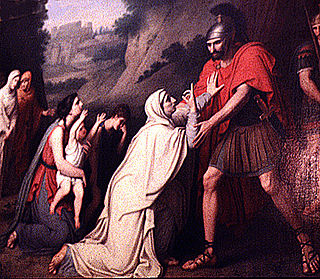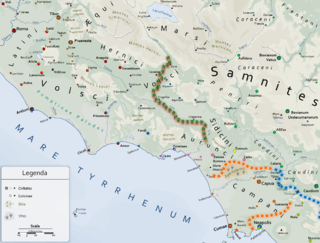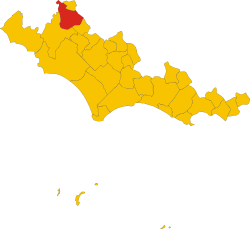
GnaeusMarcius Coriolanus was a Roman general who is said to have lived in the 5th century BC. He received his toponymic cognomen "Coriolanus" following his courageous actions during a Roman siege of the Volscian city of Corioli. He was subsequently exiled from Rome, and led troops of Rome's enemy the Volsci to besiege the city.
Year 495 BC was a year of the pre-Julian Roman calendar. At the time, it was known as the Year of the Consulship of Sabinus and Priscus. The denomination 495 BC for this year has been used since the early medieval period, when the Anno Domini calendar era became the prevalent method in Europe for naming years.
Ferentina was the patron goddess of the city Ferentinum, Latium. She was protector of the Latin commonwealth. She was also closely associated with the Roman Empire.

The Volsci were an Italic tribe, well known in the history of the first century of the Roman Republic. At the time they inhabited the partly hilly, partly marshy district of the south of Latium, bounded by the Aurunci and Samnites on the south, the Hernici on the east, and stretching roughly from Norba and Cora in the north to Antium in the south. Rivals of Rome for several hundred years, their territories were taken over by and assimilated into the growing republic by 304 BC. Rome's first emperor Augustus was of Volscian descent.
The Hernici were an Italic tribe of ancient Italy, whose territory was in Latium between the Fucine Lake and the Sacco River (Trerus), bounded by the Volsci on the south, and by the Aequi and the Marsi on the north.

The Battle of Lake Regillus was a legendary Roman victory over the Latin League shortly after the establishment of the Roman Republic and as part of a wider Latin War. The Latins were led by an elderly Lucius Tarquinius Superbus, the seventh and last King of Rome, who had been expelled in 509 BC, and his son-in-law, Octavius Mamilius, the dictator of Tusculum. The battle marked the final attempt of the Tarquins to reclaim their throne. According to legend, Castor and Pollux fought on the side of the Romans.

Antium was an ancient coastal town in Latium, south of Rome. An oppidum was founded by people of Latial culture, then it was the main stronghold of the Volsci people until it was conquered by the Romans.

The Latin League was an ancient confederation of about 30 villages and tribes in the region of Latium near the ancient city of Rome, organized for mutual defense. The term "Latin League" is one coined by modern historians with no precise Latin equivalent.

Norba, an ancient town of Latium (Adjectum), Italy. It is situated 1 mile northwest of the modern town of Norma, on the western edge of the Volscian Mountains or Monti Lepini. The town is perched above a precipitous cliff with a splendid view over the Pomptine Marshes below; the highest point stands to ca. 460 meters above sea level.

The Aurunci were an Italic tribe that lived in southern Italy from around the 1st millennium BC. They were eventually defeated by Rome and subsumed into the Roman Republic during the second half of the 4th century BC.

Satricum, an ancient town of Latium vetus, lay on the right bank of the Astura river some 60 kilometres SE of Rome in a low-lying region south of the Alban Hills, at the NW border of the Pontine Marshes. It was directly accessible from Rome via a road running roughly parallel to the Via Appia.
Appius Claudius Sabinus Regillensis or Inregillensis was the legendary founder of the Roman gens Claudia, and consul in 495 BC. He was the leading figure of the aristocratic party in the early Roman Republic.
Suessa Pometia was an ancient city of Latium, which had ceased to exist in historical times. Although the modern city of Pomezia is named after it, the exact location of the ancient city is unknown.
The Roman–Latin wars were a series of wars fought between ancient Rome and the Latins, from the earliest stages of the history of Rome until the final subjugation of the Latins to Rome in the aftermath of the Latin War.
The Roman–Volscian wars were a series of wars fought between the Roman Republic and the Volsci, an ancient Italic people. Volscian migration into southern Latium led to conflict with that region's old inhabitants, the Latins under leadership of Rome, the region's dominant city-state. By the late 5th century BC, the Volsci were increasingly on the defensive and by the end of the Samnite Wars had been incorporated into the Roman Republic. The ancient historians devoted considerable space to Volscian wars in their accounts of the early Roman Republic, but the historical accuracy of much of this material has been questioned by modern historians.

The Roman–Hernici conflicts occurred intermittently in the 5th and 4th century BCE. Both were Italic peoples settled in Latium, with the Romans speaking Latin and the Hernici an Osco-Umbrian language.
Publius Servilius Priscus Structus was a Roman statesman who served as Senator and Consul.
The Roman-Aequian wars were a series of wars during the early expansion of ancient Rome in central Italy fought against the Aequi, an Italic tribe located to their east.
Longula was a town in ancient times in the territory of the Volsci in central Italy. It was located south of Rome, and just north of the Volscian capital Antium.
Pedum was an ancient town of Latium in central Italy, located between Tibur and Praeneste, near modern Gallicano nel Lazio. The town was a member of the Latin League.














